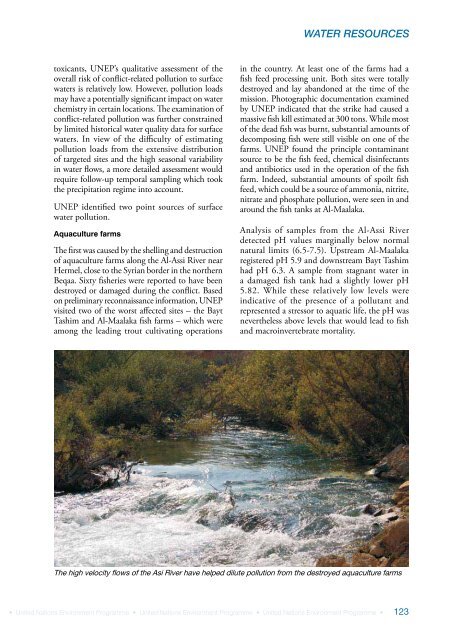LEBANONPOST-CONFLICT ENVIRONMENTAL ASSESSMENTabove both Lebanese and WHO drinking waterquality guidelines, and represent an intermediaterisk for consumers. These contamination problems,which reportedly pre-dated the conflict, were dueto overflowing sewage pipelines following heavyrains. This situation was confirmed by the <strong>UNEP</strong>team, who observed sewage spill some 20 mfrom one of the well heads. The water authoritieswere aware of this pollution and were pumpingthe groundwater continuously in an attemptto draw the contamination out of the aquifer.It is more important, however, to prevent thecontamination from occurring at all. This requiresproper sewer system design and maintenanceof control overflows. It should be noted that atthe time of the assessment, no water was beingdistributed from the contaminated well, so thatthe population was not at risk. While the pollutionsource pre-dated the conflict, the overall situationwas compounded by the war, including in terms ofservice and response capacity. Laboratory analysisof samples collected from other wells, includingfrom the Nabaa El-Tasseh spring, did not detectany coliform contamination. Nitrate, however,was detected above natural levels (18.3-18.9 mg/l)and the pH (5.74) was acidic in one of the wellsamples from Fakhr El-Din. A possible cause foracidic pH is bacterial nitrification, from sewageand/or agricultural run-off, for example.The inhabitants of Bayad, one of the devastatedneighbourhoods of Nabatiyeh, reportedwidespread cases of severe diarrhoea immediatelyafter their return, and suspected the cause to bewater contamination. At the time of the <strong>UNEP</strong>visit in October, however, only a few childrenwere reportedly still suffering from diarrhoea.Laboratory analysis did not detect any coliformin the drinking water. Of the heavy metal andchemical contaminants analysed, only copper andzinc concentrations exceeded their environmentalscreening values, but these were well belowWHO’s drinking water quality guidelines. Thehigher values of copper and zinc were probablydue to corrosion from pipework and fittings.Acidic pH and high calcium concentrations,which were detected in the Bayad water sample,are known to increase corrosion rates.Rainwater collection reservoirs are one of themain communal water supply sources in southern<strong>Lebanon</strong>. Thirty-one reservoirs were reported tohave been struck during the conflict, of whichthirteen were completely destroyed. Althoughthe Bint Jbeil reservoir was only lightly damagedby the shelling, Bint Jbeil town was heavilyhit and most of the market centre, as well assurrounding residential areas, were reduced torubble. The devastated zone falls within thereservoir’s catchment, which lies in a downstreampathway. Hence, potential contaminants fromthe debris are likely to be washed out by therains and trapped in the reservoir. Moreover,the reservoir is not lined, making it possible forpotential pollution to reach the groundwater.Laboratory analysis of the reservoir water didnot find any of the contaminants to exceed theirenvironmental screening criteria. However, faecalcoliform at concentrations of 100/100 ml weredetected, indicating that in addition to being nonpotable,the water is also unsuitable for domesticpurposes due to the risk of cross-contamination.There is clearly a need to protect the reservoirfrom potential catchment pollution, which wasworsened by the conflict. It is also recommendedthat follow-up water quality testing be undertakenfollowing the onset of the rains.Sewage infrastructure in the heavily targetedtowns and villages of the south, particularly inBint Jbeil, Khiam, Nabatiyeh, Aita El-Chaab andSiddiqine, was not adequately assessed. Septictanks need to be inspected; damaged tanks shouldbe replaced, and unharmed ones desludged. Whileinadequate disposal and treatment of sewage isa chronic problem in the south, the breakdownof sanitary services due to the 2006 conflictaggravated the situation.Surface waterAs noted previously, <strong>UNEP</strong>’s water sampling wascarried out in early to mid-October, when river andstream flows were at their minimum base levels.Moreover, many seasonal watercourses were stilldry, so that it was not possible to sample themduring the mission. Given that 90 per cent of<strong>Lebanon</strong>’s total rainfall occurs between Novemberand April 13 , the potential mobilization of conflictgeneratedcontaminants in affected catchments andtheir diffusion in the surface water environmentcould contribute to water quality changes duringthe next rainy season. Based on field observationsof pollution sources at damaged sites, including122 • United Nations Environment Programme • United Nations Environment Programme • United Nations Environment Programme •
WATER RESOURCEStoxicants, <strong>UNEP</strong>’s qualitative assessment of theoverall risk of conflict-related pollution to surfacewaters is relatively low. However, pollution loadsmay have a potentially significant impact on waterchemistry in certain locations. The examination ofconflict-related pollution was further constrainedby limited historical water quality data for surfacewaters. In view of the difficulty of estimatingpollution loads from the extensive distributionof targeted sites and the high seasonal variabilityin water flows, a more detailed assessment wouldrequire follow-up temporal sampling which tookthe precipitation regime into account.<strong>UNEP</strong> identified two point sources of surfacewater pollution.Aquaculture farmsThe first was caused by the shelling and destructionof aquaculture farms along the Al-Assi River nearHermel, close to the Syrian border in the northernBeqaa. Sixty fisheries were reported to have beendestroyed or damaged during the conflict. Basedon preliminary reconnaissance information, <strong>UNEP</strong>visited two of the worst affected sites – the BaytTashim and Al-Maalaka fish farms – which wereamong the leading trout cultivating operationsin the country. At least one of the farms had afish feed processing unit. Both sites were totallydestroyed and lay abandoned at the time of themission. Photographic documentation examinedby <strong>UNEP</strong> indicated that the strike had caused amassive fish kill estimated at 300 tons. While mostof the dead fish was burnt, substantial amounts ofdecomposing fish were still visible on one of thefarms. <strong>UNEP</strong> found the principle contaminantsource to be the fish feed, chemical disinfectantsand antibiotics used in the operation of the fishfarm. Indeed, substantial amounts of spoilt fishfeed, which could be a source of ammonia, nitrite,nitrate and phosphate pollution, were seen in andaround the fish tanks at Al-Maalaka.Analysis of samples from the Al-Assi Riverdetected pH values marginally below normalnatural limits (6.5-7.5). Upstream Al-Maalakaregistered pH 5.9 and downstream Bayt Tashimhad pH 6.3. A sample from stagnant water ina damaged fish tank had a slightly lower pH5.82. While these relatively low levels wereindicative of the presence of a pollutant andrepresented a stressor to aquatic life, the pH wasnevertheless above levels that would lead to fishand macroinvertebrate mortality.The high velocity flows of the Asi River have helped dilute pollution from the destroyed aquaculture farms• United Nations Environment Programme • United Nations Environment Programme • United Nations Environment Programme •123
















